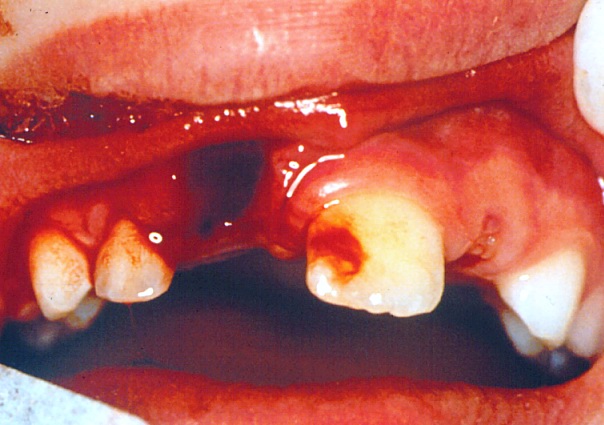Avulsion


AVULSION
Replantation at the site of injury:
The public must be well informed about what to do if a tooth is knocked out.
The best advice: Push the avulsed tooth back in place as quickly as possible.
The next best advice: Place the tooth in the childs mouth between the lower lip and the teeth. If this is not possible, put
the avulsed tooth in a glass of milk.
In all instances dental aid should be sought immediately.
Replantation in a dental clinic:
* Consider the need for local anaesthesia.
* Rinse the tooth carefully with a flow of saline from a syringe.
* Irrigate the socket gently with saline.
* Replace the tooth slowly with gentle finger pressure.
* If alveolar bone fragments prevent replantation, remove the tooth and place it in saline.
Reposition the bone, and once again attempt replantation.
* Check the position radiographically.
* Stabilize the tooth with a splint.
* Administer systemic antibiotics for 4-5 days.
* Provide tetanus prophylaxis if the avulsed tooth has been in contact with soil.
* Instruct the patient to use 0.1% chlorhexidine mouth-rinse twice daily for 1 week.
* Remove the splint after 1-2 weeks. It appears that a short splinting time favors both
periodontal and pulpal healing, whereas a rigid long-term splinting leads to dento-alveolar ankylosis.
In mature teeth where the apex is closed, avulsion results in pulpal necrosis. Therefore, endodontic treatment is started 7 - 10 days after trauma and prior to removal of the splint. Waiting longer is not recommended because of the risk of external inflammatory root resorption, if/when the pulp becomes infected. When no signs of external inflammatory root resorption can be detected, endodontic therapy can be done either with short (1 - 4 weeks) or long term (12 months or until PDL returns 'normal') calcium hydroxide treatment. When external inflammatory root resorption is present, long term (12 months or until PDL returns 'normal') calcium hydroxide treatment is always used.